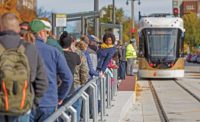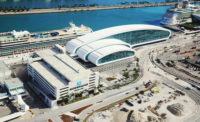Owner: City of Milwaukee
General Contractor: Kiewit Infrastructure Corp.
Lead Design Firm: HNTB Corp.
Structural Engineer: HNTB Corp.
The Hop is the first modern embedded-track streetcar system in Milwaukee. The $100-million M-Line, the first section of the city’s transit system, consists of a 2.1-mile route with 18 stations that runs from Burns Commons near Lake Michigan to the Milwaukee Intermodal Station on the southwest side of the city.
The system was designed by HNTB with innovative solutions to common transit problems. Intelligent transportation system (ITS) elements allow Milwaukee to monitor the Hop’s usage. ITS utilizes GPS and wireless communication with transit-signal-only phases to provide efficient and safe operations. It’s one of the first transit applications of wireless switch technology via GPS in the U.S., the team says.
Omaha-based Kiewit Infrastructure began construction in March 2017, nearly 59 years after Milwaukee’s previous streetcar shut down. The work on the new streetcar included $20 million in utility relocations and 3.7 miles of newly constructed track alignment. One of HNTB’s and Kiewit’s major challenges was that downtown Milwaukee is littered with vaulted sidewalks, which are hollowed-out areas beneath public sidewalks. The hollow walks presented structural challenges, as there is no fill to hold poles to support overhead power lines.
The Hop derives much of its energy from a source other than overhead catenary wires. Nearly 40% of the route does not have an overhead system. As a result, the streetcars carry 30 lithium-ion batteries, enabling the Hop to run on battery power for up to six miles.
“It’s off-wire technology,” HNTB Wisconsin office leader Ashley Booth says. “It’s one of the first streetcars to operate on lithium-ion batteries, which helps save on cost in addition to providing an important aesthetic environment.”
The Hop measures ridership via an automatic passenger counter that has three sensors on each door of the vehicle. Each time an infrared beam is broken, it records the number of passengers as they enter the car. In 2019, the M-Line system transported approximately 760,321 commuters in a city with a population of 1.5 million.
From 2017 to 2018, there was an overall increase of real-estate value of $263 million within a quarter mile of the M-Line. The first planned extension (the L Line) is under construction.






